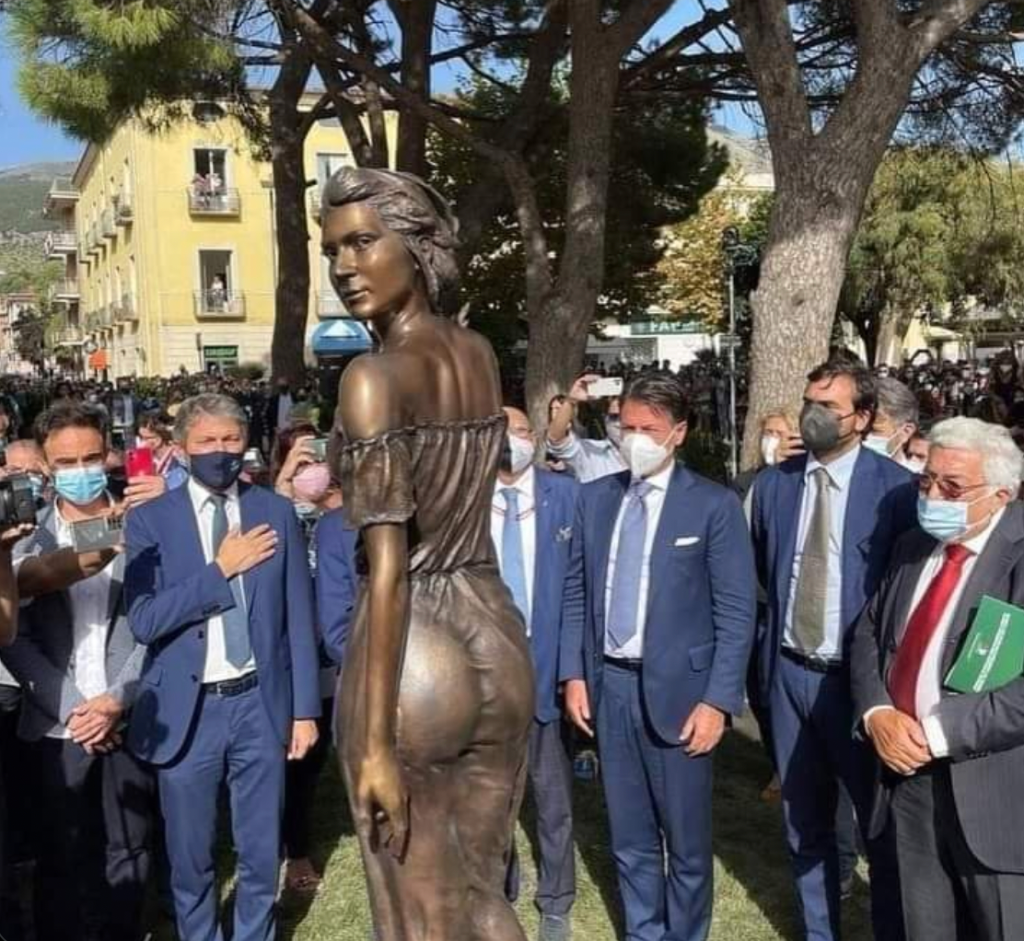 The sculpture by Emanuele Stifano unveiled by former PM Giuseppe Conte. Via Twitter courtesy Laura Boldrini
The sculpture by Emanuele Stifano unveiled by former PM Giuseppe Conte. Via Twitter courtesy Laura Boldrini
The latest public monument to draw a bitter outcry is a sexually suggestive statue of a female field worker in Italy, which was accused of promoting sexism by politicians this week.
The bronze statue, which depicts a young woman wearing a transparent, body-hugging dress, was presented on Saturday in a ceremony attended by a mostly male audience, including former prime minister Giuseppe Conte, in the city of Sapri, in Italy’s southern Campania region. Created by sculptor Emanuele Stifano, it is a tribute to the 19th-century poem “La Spigolatrice di Sapri” (The Gleaner of Sapri) by Luigi Mercantini, which tells the story of Carlo Pisacane, an early socialist thinker who led a failed attempt to liberate the Bourbon Kingdom of Naples.
Mercantini’s poem is narrated from the point of view of a woman working in the fields near Sapri, who first spots the landing of a ship carrying Pisacane and 300 soldiers. Their attempted socialist revolution was a disaster, with most of his army slain or captured by the Bourbon forces and local population, who had been misled to believe Pisacane’s intentions were to pillage the kingdom. Pisacane died in the battle, but his efforts are widely honored in Italy as the symbolic precursor to Giuseppe Garibaldi’s successful campaign to topple the Bourbon monarchy.
Italian politician Laura Boldrini called the statue an “offense to women and the history it should celebrate,” asking in Italian on Twitter: “How can even institutions accept the representation of a woman as a sexualized body?”
Boldrini’s remarks were joined by a call from a group of female politicians from the Democratic party to topple the statue. “Once again, we have to suffer the humiliation of seeing ourselves represented in the form of a sexualized body, devoid of soul and without any connection with the social and political issues of the story,” the group said in a statement. They added that the statue did not reflect the struggle for independence from Bourbon rule nor the “self-determination of a woman who chooses not to go to work in order to take sides against the oppressor.” Stifano defended the work, writing on Facebook that if he had been afforded full creative liberty on its design, the statue would have been “completely naked . . . simply because I am a lover of the human body.” He added that it was “useless” to offer explanations for the artwork to critics “who absolutely only want to see depravity.”
Antonio Gentile, the mayor of Sapri, said in a statement that throughout the review process, “nobody had criticized or distorted the work of art.”
The row over Stifano’s statue is reminiscent of one of the most polarizing artworks of 2020, a monument to 18th-century women’s rights activist Mary Wollstonecraft, often dubbed the “mother of feminism,” installed in north London. The silver sculpture drew criticism and ridicule from many who questioned its inclusion of a slim, naked female figure. The campaign to commission the sculpture, called Mary on the Green, wrote on its website that the naked woman represents “an everywoman” that “emerges out of organic matter, almost like a birth.”
Source link : https://www.artnews.com/art-news/news/sapri-italy-monument-sexism-allegations-1234605053












